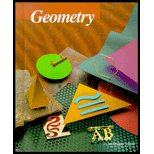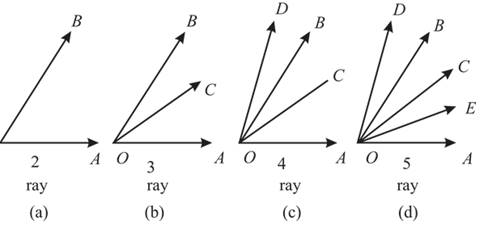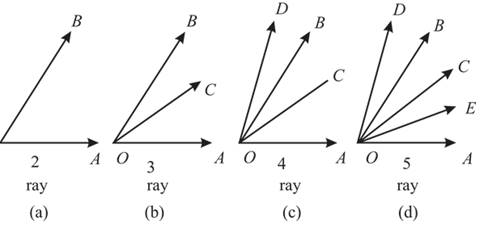
(a)
To find: The number of rays and
(a)
Answer to Problem 35WE
The figure (c) has 6 angles and figure (d) has 10 angles.
Explanation of Solution
Given information:
The given figure can be named as:

Formula used:
Property of Non collinear rays.
Calculation:
As it can be seen from the above figure it can be observe that figure (c) has 4 rays and 6 angle that is,
Similarly figure (d) has 5 rays and 10 angles that is,
Therefore, the figure (c) has 6 angles and figure (d) has 10 angles.
Conclusion:
The figure (c) has 6 angles and figure (d) has 10 angles.
(b)
To get: The number of angles formed by six non collinear rays that have the same end point.
(b)
Answer to Problem 35WE
It can be predicted that six non collinear rays having same end point will have 15 angles.
Explanation of Solution
Given information:
The given figure can be named as:

Formula used:
Property of Non collinear rays.
Calculation:
As it can be seen from the above figure it can be observe that angles are increasing in a particular pattern with the increase in no of rays.
From the first to last figure as rays are increasing with the difference of one, the angles are increasing with difference of 2, 3 and 4.
Therefore, it can be predicted that six non collinear rays having same end point will have 15 angles.
Conclusion:
It can be predicted that six non collinear rays having same end point will have 15 angles.
(c)
To find:The expression that gives the number of angles formed by nnon collinear rays that have the same endpoint.
(c)
Answer to Problem 35WE
The general expression for the number of angles formed by n rays having same endpoint is
Explanation of Solution
Given information:
The given figure can be named as:

Formula used:
Non collinear rays is used
Calculation:
From the above figure it can be observe that the angles are increasing in a particular order.
Thus the general expression for the number of angles formed by n rays having same endpoint is
This can be verified by substituting various values such as 1, 2, ….
Conclusion:
The general expression for the number of angles formed by n rays having same endpoint is
Chapter 1 Solutions
McDougal Littell Jurgensen Geometry: Student Edition Geometry
Additional Math Textbook Solutions
Elementary Algebra: Concepts and Applications (10th Edition)
Single Variable Calculus: Early Transcendentals (2nd Edition) - Standalone book
A Problem Solving Approach To Mathematics For Elementary School Teachers (13th Edition)
Calculus and Its Applications (11th Edition)
Linear Algebra with Applications (9th Edition) (Featured Titles for Linear Algebra (Introductory))
Thomas' Calculus: Early Transcendentals (14th Edition)
 Elementary Geometry For College Students, 7eGeometryISBN:9781337614085Author:Alexander, Daniel C.; Koeberlein, Geralyn M.Publisher:Cengage,
Elementary Geometry For College Students, 7eGeometryISBN:9781337614085Author:Alexander, Daniel C.; Koeberlein, Geralyn M.Publisher:Cengage, Elementary Geometry for College StudentsGeometryISBN:9781285195698Author:Daniel C. Alexander, Geralyn M. KoeberleinPublisher:Cengage Learning
Elementary Geometry for College StudentsGeometryISBN:9781285195698Author:Daniel C. Alexander, Geralyn M. KoeberleinPublisher:Cengage Learning

